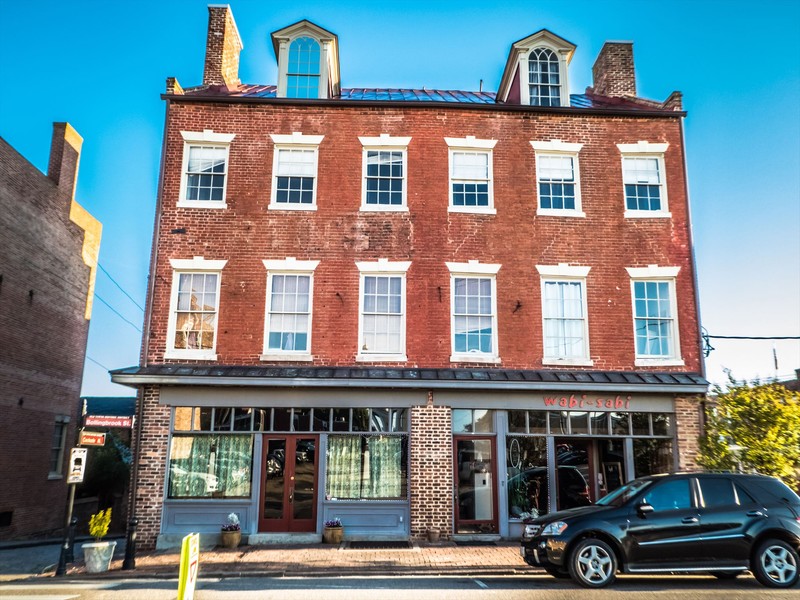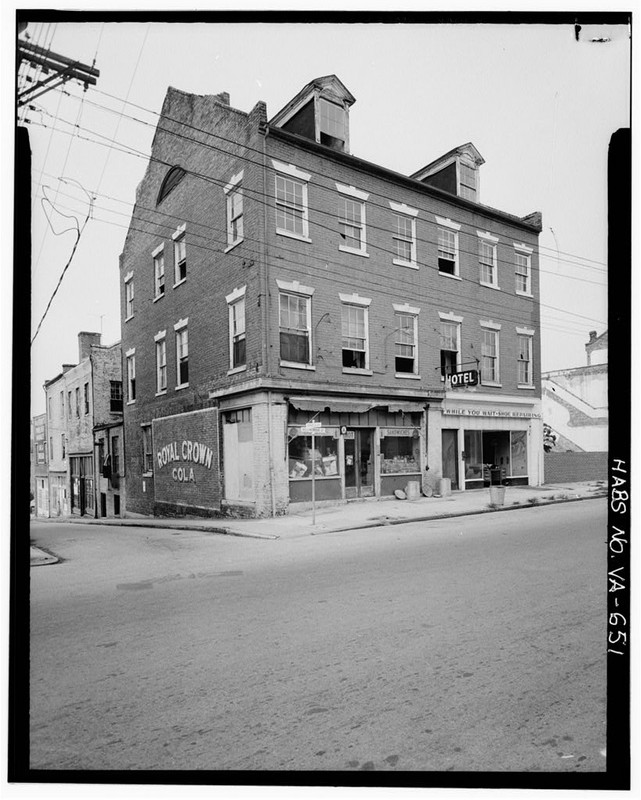Nathaniel Friend House
Introduction
Text-to-speech Audio
Built between 1815 and 1816, the Nathaniel Friend House is a historic home and commercial building in the Petersburg Old Town Historic District. It was built by merchant and plantation owner, Nathaniel Friend, Jr. With its notable residents and beautiful Federal architecture, the house was added to the National Register of Historic Places in 1976.
Images
The Nathaniel Friend House is a beautiful surviving example of Federal architecture in Petersburg.

The Historic American Buildings Survey (HABS) documented the Nathaniel Friend House in 1968. Photo by HABS.

The HABS also noted that the house is "an excellent example of the combination commercial-living row [houses] typical of the period." Photo by HABS.
![The HABS also noted that the house is "an excellent example of the combination commercial-living row [houses] typical of the period." Photo by HABS.](https://storage.googleapis.com/clio-images/medium_45711.117312.jpg)
Backstory and Context
Text-to-speech Audio
At the turn of the nineteenth century, Petersburg was a prosperous center of commerce in Virginia. Large warehouses packaged tobacco and prepared it for export. This laborious task was done by hand by enslaved people, who comprised about half the population in Petersburg at the time. Slaves were also a profitable commodity that local business people traded, purchased, and rented to work in urban factories or rural plantations. The city served as a "depot" for imported supplies distributed throughout the South. Such conditions made Petersburg an attractive city for Nathaniel Friend, Jr., an import-export merchant and owner of the White Hall Plantation in Prince George County. Friend arrived in Petersburg around 1808, and specialized in understanding market demands for certain goods, both domestically and internationally.1
By 1815, Petersburg was Virginia's third largest city. That year, a "great fire" swept through downtown Petersburg, destroying nearly two-thirds of the city. As part of broad, ambitious efforts to rebuild, Friend constructed a brick house along Bollingbrook Street with a two-story outdoor kitchen and smokehouse in the backyard. Today, only the house stands. The National Register of Historic Places nomination writers called the Nathaniel Friend House "an outstanding example of Federal architecture," a style that flourished after the American Revolution. The Federal style's clean lines, symmetry, and rich brickwork helped characterize the young nation's urban landscape as classic and mature. Another Federal style building, Farmers Bank, was built next door to the Nathaniel Friend House in 1817. Together, these buildings evoke the Federal architectural style popular in Petersburg in the early nineteenth century.2
The house stayed in the Friend family for around 100 years until it was passed through several hands. The first floor housed a number of shops over the years, including a general store and shoe repair shop. In the mid-twentieth century, Frank and Susie Hudson owned a battery and ignition shop on the first floor and resided in the top floors of the house. The house sat vacant for a while and, in 1968, was surveyed as part of an effort throughout Petersburg to document historic buildings. The Historic American Buildings Survey determined its condition "poor" but still retaining its architectural character. Then, the house, like Farmers Bank, was acquired by the Fort Henry Branch of the Association for the Preservation of Virginia Antiquities, now known as Preservation Virginia, and restored as part of an effort in the late twentieth century to promote tourism. Currently, it is home to a restaurant and lounge. The Nathaniel Friend House serves a new commercial purpose as historic preservation and revitalization continue in downtown Petersburg.3
By 1815, Petersburg was Virginia's third largest city. That year, a "great fire" swept through downtown Petersburg, destroying nearly two-thirds of the city. As part of broad, ambitious efforts to rebuild, Friend constructed a brick house along Bollingbrook Street with a two-story outdoor kitchen and smokehouse in the backyard. Today, only the house stands. The National Register of Historic Places nomination writers called the Nathaniel Friend House "an outstanding example of Federal architecture," a style that flourished after the American Revolution. The Federal style's clean lines, symmetry, and rich brickwork helped characterize the young nation's urban landscape as classic and mature. Another Federal style building, Farmers Bank, was built next door to the Nathaniel Friend House in 1817. Together, these buildings evoke the Federal architectural style popular in Petersburg in the early nineteenth century.2
The house stayed in the Friend family for around 100 years until it was passed through several hands. The first floor housed a number of shops over the years, including a general store and shoe repair shop. In the mid-twentieth century, Frank and Susie Hudson owned a battery and ignition shop on the first floor and resided in the top floors of the house. The house sat vacant for a while and, in 1968, was surveyed as part of an effort throughout Petersburg to document historic buildings. The Historic American Buildings Survey determined its condition "poor" but still retaining its architectural character. Then, the house, like Farmers Bank, was acquired by the Fort Henry Branch of the Association for the Preservation of Virginia Antiquities, now known as Preservation Virginia, and restored as part of an effort in the late twentieth century to promote tourism. Currently, it is home to a restaurant and lounge. The Nathaniel Friend House serves a new commercial purpose as historic preservation and revitalization continue in downtown Petersburg.3
Sources
1. Barnes, Artisan Workers in the Upper South, 17-18; Eastman, The Great Fire of Petersburg, Virginia, 24-28; National Park Service, "Nathaniel Friend House," National Register of Historic Places.
2. National Park Service, "Nathaniel Friend House," National Register of Historic Places; National Park Service, "Petersburg Old Town Historic District," National Register of Historic Places; Poppeliers and Chambers, What Style is it?, 26-31; "Federal (Adam)," Architectural Styles of America and Europe.
3. National Park Service, "Nathaniel Friend House," National Register of Historic Places; National Park Service, "Nathaniel Friend, Jr. House;" Historic American Buildings Survey; Hill's Petersburg City Directory (1958), 190.
Barnes, L. Diane. Artisan Workers in the Upper South: Petersburg, Virginia, 1820-1865. Baton Rouge: Louisiana State University Press, 2008.
Eastman, Tamar J. The Great Fire of Petersburg, Virginia. Charleston, SC: The History Press, 2016.
"Federal (Adam)." Architectural Styles of America and Europe. Accessed September 2017. https://architecturestyles.org/federal-adam/
Hill's Petersburg City Directory. Richmond: Hill Directory Company, Inc., 1958.
National Park Service. "Nathaniel Friend House." National Register of Historic Places Inventory-Nomination Form. Prepared by Virginia Historic Landmarks Commission staff. Washington, D.C.: National Park Service, Department of the Interior, 1976. http://www.dhr.Virginia.gov/registers/Cities/Petersburg/123-0066_Friend,Nathaniel,House_1976_Final_N...
National Park Service. "Nathaniel Friend, Jr. House." Historic American Buildings Survey. Prepared by James C. Massey and Randall J. Biallas. National Park Service, U.S. Department of the Interior, 1968. From Prints and Photographs Division, Library of Congress (HABS VA-651) http://cdn.loc.gov/master/pnp/habshaer/va/va0300/va0355/data/va0355data.pdf
National Park Service. "Petersburg Old Town Historic District." National Register of Historic Places Inventory-Nomination Form. Prepared by Virginia Historic Landmarks Commission staff. Washington, D.C.: National Park Service, Department of the Interior, 1980. http://www.dhr.Virginia.gov/registers/Cities/Petersburg/123-0097_Petersburg_Old_Town_HD_Final_Nomina...
Poppeliers, John C. and S. Allen Chambers, Jr. What Style is it? A Guide to American Architecture. John C. Wiley and Sons: 2003.
2. National Park Service, "Nathaniel Friend House," National Register of Historic Places; National Park Service, "Petersburg Old Town Historic District," National Register of Historic Places; Poppeliers and Chambers, What Style is it?, 26-31; "Federal (Adam)," Architectural Styles of America and Europe.
3. National Park Service, "Nathaniel Friend House," National Register of Historic Places; National Park Service, "Nathaniel Friend, Jr. House;" Historic American Buildings Survey; Hill's Petersburg City Directory (1958), 190.
Barnes, L. Diane. Artisan Workers in the Upper South: Petersburg, Virginia, 1820-1865. Baton Rouge: Louisiana State University Press, 2008.
Eastman, Tamar J. The Great Fire of Petersburg, Virginia. Charleston, SC: The History Press, 2016.
"Federal (Adam)." Architectural Styles of America and Europe. Accessed September 2017. https://architecturestyles.org/federal-adam/
Hill's Petersburg City Directory. Richmond: Hill Directory Company, Inc., 1958.
National Park Service. "Nathaniel Friend House." National Register of Historic Places Inventory-Nomination Form. Prepared by Virginia Historic Landmarks Commission staff. Washington, D.C.: National Park Service, Department of the Interior, 1976. http://www.dhr.Virginia.gov/registers/Cities/Petersburg/123-0066_Friend,Nathaniel,House_1976_Final_N...
National Park Service. "Nathaniel Friend, Jr. House." Historic American Buildings Survey. Prepared by James C. Massey and Randall J. Biallas. National Park Service, U.S. Department of the Interior, 1968. From Prints and Photographs Division, Library of Congress (HABS VA-651) http://cdn.loc.gov/master/pnp/habshaer/va/va0300/va0355/data/va0355data.pdf
National Park Service. "Petersburg Old Town Historic District." National Register of Historic Places Inventory-Nomination Form. Prepared by Virginia Historic Landmarks Commission staff. Washington, D.C.: National Park Service, Department of the Interior, 1980. http://www.dhr.Virginia.gov/registers/Cities/Petersburg/123-0097_Petersburg_Old_Town_HD_Final_Nomina...
Poppeliers, John C. and S. Allen Chambers, Jr. What Style is it? A Guide to American Architecture. John C. Wiley and Sons: 2003.
